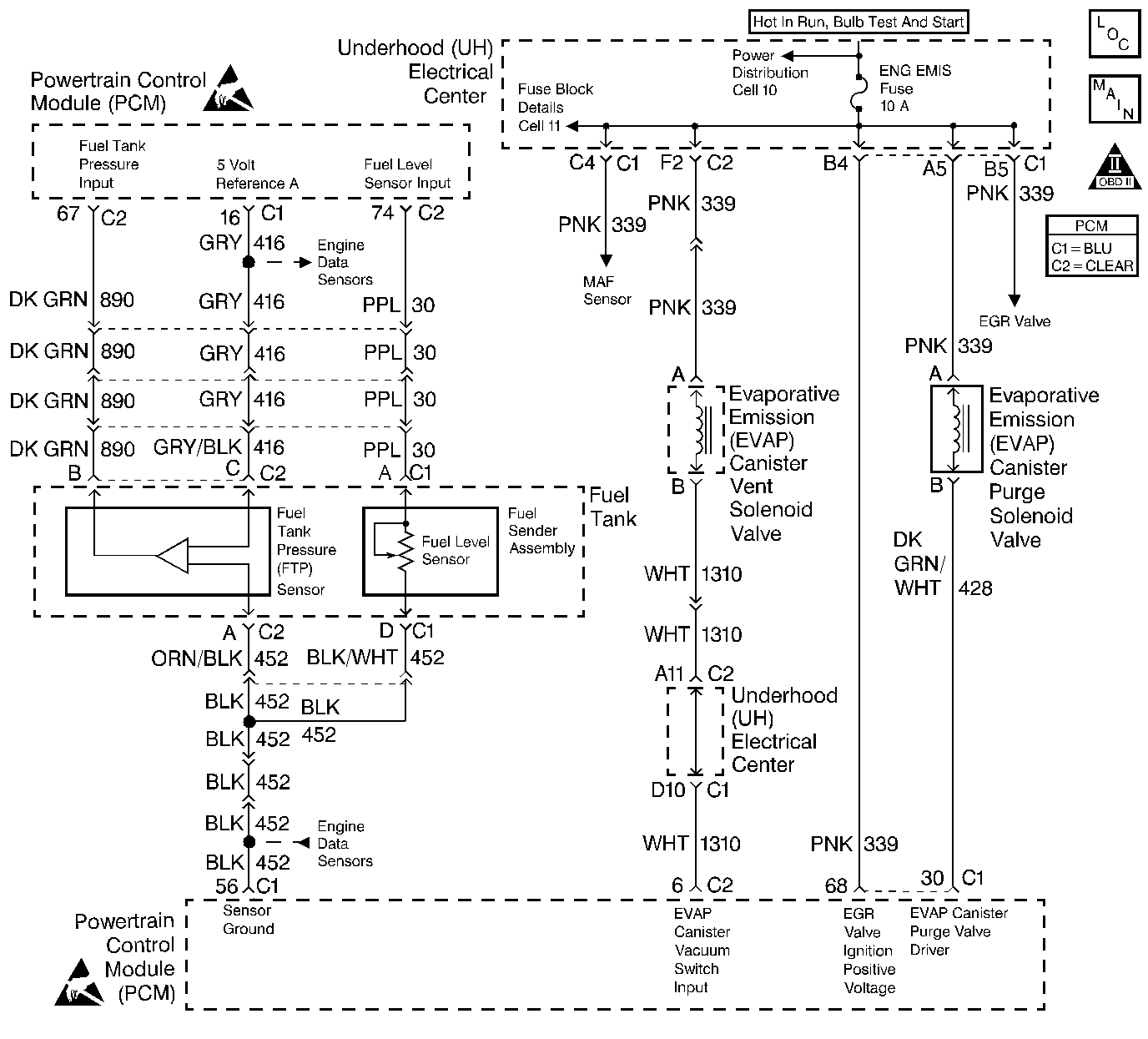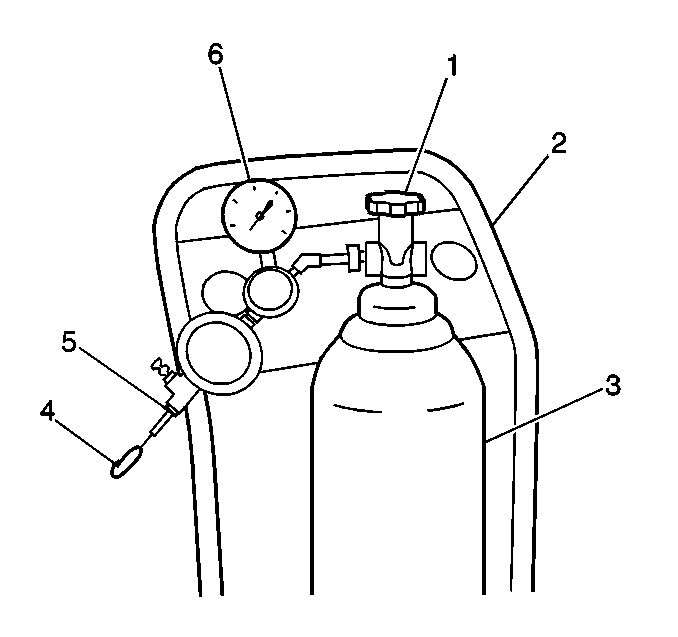Evaporative Emission Control System Diagnosis System Check

Circuit Description
The evaporative system includes the following components:
| • | The fuel tank. |
| • | The EVAP vent solenoid. |
| • | The fuel tank pressure sensor. |
| • | The fuel pipes and hoses. |
| • | The vapor lines. |
| • | The fuel cap. |
| • | The evaporative emission canister. |
| • | The purge lines. |
| • | The EVAP purge solenoid. |
The EVAP purge solenoid valve allows manifold vacuum to purge the canister. The Powertrain Control Module (PCM) supplies a ground to energize the solenoid valve (purge on). The EVAP purge solenoid control is Pulse Width Modulated (PWM) or turned on and off several times a second. The duty cycle (pulse width) is determined by engine operating conditions including load, throttle position, coolant temperature and ambient temperature. The duty cycle is calculated by the PCM and the output is commanded when the appropriate conditions have been met.
The EVAP Vent solenoid is used to seal the EVAP system during the EVAP leak diagnostic tests. The fuel tank pressure sensor is used to monitor vacuum in the system during the diagnostic tests.
A stuck closed EVAP purge solenoid, stuck open EVAP vent solenoid, disconnected or damaged EVAP purge line or vent hose, leaking fuel cap, or fill neck should set a DTC P0440 Evaporative Emission (EVAP) System . A small leak in the EVAP system should set a DTC P0442 Evaporative Emission (EVAP) System Small Leak Detected . An EVAP vent solenoid stuck closed, a restricted vent hose, or a blocked EVAP canister should set a DTC P0446 Evaporative Emission (EVAP) Vent System Performance . A continuous purge condition with no purge commanded by the PCM (EVAP purge solenoid stuck open or leaking) should set a DTC P1441 Evaporative Emission (EVAP) System Flow During Non-Purge . Refer to the DTC tables for further diagnostic procedures regarding the EVAP system.
Diagnostic Aids
Check for the following conditions:
| • | Poor connection at PCM. |
| Inspect harness connectors for backed out terminals, improper mating, broken locks, improperly formed or damaged terminals, and poor terminal to wire connection. |
| • | Damaged harness. |
| Inspect the wiring harness for damage. If the harness appears to be OK, observe the Fuel Tank Pressure display on the scan tool while moving connectors and wiring harnesses related to the sensor. A change in the display will indicate the location of the malfunction. |
| • | Incorrect EVAP purge or vacuum source line routing. |
| Verify that the source vacuum and EVAP purge lines to the canister purge valve are not switched. |
Important: Although these diagnostics are considered type A, they act like type B diagnostics under certain conditions. Whenever the EVAP diagnostics report that the system has passed, or if the battery has been disconnected, the diagnostic must fail during two consecutive cold start trips before setting a DTC. The initial failure is not reported to the diagnostic executive or displayed on a scan tool. A passing system always reports to the diagnostic executive immediately.
Test Description
Number(s) below refer to the step number(s) on the Diagnostic Table.
-
The PCM will command the EVAP purge and vent solenoids closed with the scan tool Seal System EVAP output control function activated. Fuel tank pressure should not decrease under these conditions.
-
The PCM commands the EVAP purge solenoid off (open) and the vent solenoid off (closed) with the scan tool System Perf. EVAP output control function activated. Engine vacuum should cause fuel tank pressure to decrease when System Perf. is activated.
Step | Action | Value(s) | Yes | No |
|---|---|---|---|---|
1 | Was the Powertrain On Board Diagnostic (OBD) System Check performed? | -- | ||
2 |
Is Fuel Tank Pressure at the specified value? | 0 in. H2O | ||
3 |
Important: : Before continuing with diagnosis, zero the EVAP Pressure and Vacuum
gauges on the
Is the Fuel Tank Pressure at the specified value? | 5 in. H2O | ||
4 | Monitor the EVAP pressure gauge on the EVAP pressure/purge diagnostic station while commanding the vent solenoid off (Open). Does the EVAP pressure decrease to the specified value within 5 seconds? | 0 in. H2O | Go to DTC P0446 Evaporative Emission (EVAP) Vent System Performance | |
Is the vacuum increasing to a value greater than the specified value? | 0 in. H2O | Go to DTC P1441 Evaporative Emission (EVAP) System Flow During Non-Purge | ||
Did vacuum increase to a value greater than the specified value? | -5 in H2O | System OK |
Evaporative Emission Control System Diagnosis FTP Sensor Diagnosis

Circuit Description
The Fuel Tank Pressure sensor responds to changes in fuel tank pressure or vacuum. The fuel tank pressure sensor signal voltage to the PCM varies from a minimum of about 0.2 volts with pressure in the fuel tank to above 4 volts with a high vacuum situation in the fuel tank (EVAP canister vent valve stuck closed). The fuel tank pressure sensor is used to detect vacuum decay and excess vacuum during the enhanced EVAP diagnostic routine.
The Fuel Tank Pressure Sensor Diagnosis table is intended to isolate and diagnose electrical problems with the sensor wiring or the sensor.
Diagnostic Aids
Check for the following conditions:
| • | Inspect PCM harness connectors for backed out terminals, improper mating, broken locks, improperly formed or damaged terminals, and poor terminal to wire connection. |
| • | Inspect the wiring harness for damage. |
| • | If the harness appears to be OK, observe the Fuel Tank Pressure display on the scan tool while moving connectors and wiring harnesses related to the sensor. A change in the display will indicate the location of the malfunction. |
Test Description
Number(s) below refer to the step number(s) on the Diagnostic Table.
-
This vehicle is equipped with a PCM which utilizes an Electrically Erasable Programmable Read Only Memory (EEPROM). When the PCM is being replaced, the new PCM must be programmed. Refer to Powertrain Control Module Replacement/Programming .
Step | Action | Value(s) | Yes | No |
|---|---|---|---|---|
1 | Was the Powertrain On Board Diagnostic (OBD) System Check performed? | -- | ||
2 |
Is voltage near the specified value? | 5.0 V | ||
3 | Check the 5 Volt Reference A circuit for a poor terminal connection at the PCM. Was a problem found? | -- | ||
4 | Check for an open or a faulty connection in the 5 Volt Reference A circuit to the fuel tank pressure sensor harness connector. Was a problem found? | -- | ||
5 |
Is voltage between the specified values? | 1.3 V-1.7 V | ||
6 | Check the fuel tank pressure sensor signal circuit for a poor terminal connection at the PCM. Was a problem found? | -- | ||
7 | Check the fuel tank pressure signal circuit between the fuel tank pressure sensor connector and the PCM for an open, short to ground, or short to voltage. Was a problem found? | -- | ||
8 | Check the sensor ground circuit for a poor terminal connection at the PCM. Was a problem found? | -- | ||
9 | Check for an open or a faulty splice in the sensor ground circuit. Was a problem found? | -- | ||
10 | Check for a poor circuit terminal connection at the fuel tank pressure sensor connector. Was a problem found? | -- | ||
11 | Replace the faulty harness connector terminals as necessary. Refer to Repair Procedures in Electrical Diagnosis. Is the action complete? | -- | -- | |
12 | Locate and repair open/short circuit in wiring harness as necessary. Refer to Repair Procedures in Electrical Diagnosis. Is the action complete? | -- | -- | |
13 | Replace the fuel tank pressure sensor. Refer to Fuel Tank Pressure Sensor Replacement Is the action complete? | -- | -- | |
Replace the PCM. Important: : The replacement PCM must be programmed. Refer to Powertrain Control Module Replacement/Programming . Is the action complete? | -- | -- | ||
15 |
Is Fuel Tank Pressure at the specified value? | 0 in. H2O | ||
16 |
Is Fuel Tank Pressure at the specified value? | 5 in. H2O | System OK |

